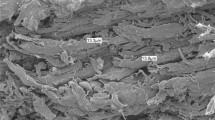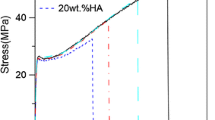Abstract
A micromechanical model was developed to predict the elastic moduli of hydroxyapatite (HA) whisker reinforced polymer biocomposites based upon the elastic properties of each phase and the reinforcement volume fraction, morphology, and preferred orientation. The effects of the HA whisker volume fraction, morphology, and orientation distribution were investigated by comparing model predictions with experimentally measured elastic moduli for HA whisker reinforced high-density polyethylene composites. Predictions using experimental measurements of the HA whisker aspect ratio distribution and orientation distribution were also compared to common idealized assumptions. The best model predictions were obtained using the experimentally measured HA whisker aspect ratio distribution and orientation distribution.
Similar content being viewed by others
References
W. Bonfield, M.D. Grynpas, A.E. Tully, J. Bowman, J. Abram: Hydroxyapatite reinforced polyethylene—A mechanically compatible implant material for bone-replacement. Biomaterials 2, 185 (1981).
W. Bonfield: Composites for bone replacement. J. Biomed. Eng. 10, 522 (1988).
W. Bonfield, J.A. Bowman and M.D. Grynpas: Composite material for use in orthopaedics, U.S. Patent No. 5 017 627 (1991).
N.H. Ladizesky, I.M. Ward, W. Bonfield: Hydroxyapatite/high-performance polyethylene fibre composites for high-load-bearing bone replacement materials. J. Appl. Polym. Sci. 65, 1865 (1997).
M. Wang, R. Joseph, W. Bonfield: Hydroxyapatite-polyethylene composites for bone substitution: Effects of ceramic particle size and morphology. Biomaterials 19, 2357 (1998).
M. Bonner, L.S. Saunders, I.M. Ward, G.W. Davies, M. Wang, K.E. Tanner, W. Bonfield: Anisotropic mechanical properties of oriented HAPEX™. J. Mater. Sci. 37, 325 (2002).
L. Di Silvio, M.J. Dalby, W. Bonfield: Osteoblast behaviour on HAP/PE composite surfaces with different HA volumes. Biomaterials 23, 101 (2002).
E.J. Harper, J.C. Behiri, W. Bonfield: Flexural and fatigue properties of a bone cement based upon polyethylmethacrylate and hydroxyapatite. J. Mater. Sci.: Mater. Med. 6, 799 (1995).
K.E. Watson, K.S. Tenhuisen, P.W. Brown: The formation of hydroxyapatite-calcium polyacrylate composites. J. Mater. Sci.: Mater. Med. 10, 205 (1999).
Y.E. Greish, P.W. Brown: An evaluation of mechanical property and microstructural development in HAp-Ca polycarboxylate biocomposites prepared by hot pressing. J. Biomed. Mater. Res. Appl. Biomater. 53, 421 (2000).
M. Kobayashi, T. Nakamura, Y. Okada, A. Fukumoto, T. Furukawa, H. Kato, T. Kokobu, T. Kikutani: Bioactive bone cement: Comparison of apatite and wollastonite containing glass-ceramic, hydroxyapatite, and β-tricalcium phosphate fillers on bone bonding strength. J. Biomed. Mater. Res. 42, 223 (1998).
S. Shinzato, M. Kobayashi, W.F. Mousa, M. Kamimura, M. Neo, Y. Kitamura, T. Kokubo, T. Nakamura: Bioactive polymethyl methacrylate-based bone cement: Comparison of glass beads, apatite- and wollastonite-containing glass-ceramic, and hydroxyapatite fillers on mechanical and biological properties. J. Biomed. Mater. Res. 51, 258 (2000).
S. Higashi, T. Yamamura, T. Nakamura, Y. Ikada, S.H. Hyon, K. Jamshidi: Polymer-hydroxyapatite composites for biodegradable bone fillers. Biomaterials 7, 183 (1986).
C.C.P.M Verheyen, J.R. de Wijn, C.A. van Blitterswijk, K. de Groot: Evaluation of hydroxylapatite/poly(L-lactide) composites: Mechanical behavior. J. Biomed. Mater. Res. 26, 1277 (1992).
M. Kikuchi, Y. Suetsugu, J. Tanaka, M. Akao: Preparation and mechanical properties of calcium phosphate/copoly-L-lactide composites. J. Mater. Sci.: Mater. Med. 8, 361 (1997).
N. Ignjatovic, S. Tomic, M. Dakic, M. Miljkovic, M. Plavsic, D. Uskokovic: Synthesis and properties of hydroxyapatite/poly-L-lactide composite biomaterials. Biomaterials 20, 809 (1999).
Y. Shikinami, M. Okuno: Bioresorbable devices made of forged composites of hydroxyapatite (HA) particles and poly-L-lactide (PLLA): Part I. Basic characteristics. Biomaterials 20, 859 (1999).
C. Durucan, P.W. Brown: Low temperature formation of calcium-deficient hydroxyapatite-PLA/PLGA composites. J. Biomed. Mater. Res. 51, 717 (2000).
C. Durucan, P.W. Brown: Calcium-deficient hydroxyapatite-PLGA composites: Mechanical properties and microstructural characterization. J. Biomed. Mater. Res. 51, 726 (2000).
M.S. Abu Bakar, P. Cheang, K.A. Khor: Thermal processing of hydroxyapatite reinforced polyetheretherketone composites. J. Mater. Process. Technol. 89–90, 462 (1999).
M.S. Abu Bakar, P. Cheang, K.A. Khor: Mechanical properties of injection molded hydroxyapatite-polyetheretherketone biocomposites. Compos. Sci. Technol. 63, 421 (2003).
M.S. Abu Bakar, P. Cheang, K.A. Khor: Tensile properties and microstructural analysis of spheroidized hydroxyapatitepoly (etheretherketone) biocomposites. Mater. Sci. Eng., A 345, 55 (2003).
M.S. Abu Bakar, M.H.W Cheng, S.M. Tang, S.C. Yu, K. Liao, C.T. Tan, K.A. Khor, P. Cheang: Tensile properties, tension-tension fatigue and biological response of polyetheretherketone-hydroxyapatite composites for load-bearing orthopedic implants. Biomaterials 24, 2245 (2003).
M. Wang: Developing bioactive composite materials for tissue replacement. Biomaterials 24, 2133 (2003).
S.M. Tang, P. Cheang, M.S. Abu Bakar, K.A. Khor, K. Liao: Tension-tension fatigue behavior of hydroxyapatite reinforced polyetheretherketone composites. Int. J. Fatigue 26, 49 (2004).
L.L. Hench: Bioceramics: From concept to clinic. J. Am. Ceram. Soc. 74, 1487 (1991).
R.Z. LeGeros, J.P. LeGeros: Dense hydroxyapatite, in An Introduction to Bioceramics, edited by L.L. Hench and J. Wilson (World Scientific Publishing Co., NJ, 1993), pp. 139–180.
L.L. Hench: Bioceramics. J. Am. Ceram. Soc. 81, 1705 (1998).
R. Holmes, V. Mooney, R. Bucholz, A. Tencer: A coralline hydroxyapatite bone graft substitute. Clin. Orthop. Relat. Res. 188, 252 (1984).
H. Oguchi, K. Ishikawa, K. Mizoue, K. Seto, G. Eguchi: Long-term histological evaluation of hydroxyapatite ceramics in humans. Biomaterials 16, 33 (1995).
J.L. Dornhoffer: Hearing results with the Dornhoffer ossicular replacement prostheses. Laryngoscope 108, 531 (1998).
K. Hasegawa, C.H. Turner, D.B. Burr: Contribution of collagen and mineral to the elastic anisotropy of bone. Calcif. Tissue Int. 55, 381 (1994).
Y. Takano, C.H. Turner, D.B. Burr: Mineral anisotropy in mineralized tissues is similar among species and mineral growth occurs independently of collagen orientation in rats: Results from acoustic velocity measurements. J. Bone Miner. Res. 11, 1292 (1996).
S. Weiner, P.A. Price: Disaggregation of bone into crystals. Calcif. Tissue Int. 39, 365 (1986).
S. Weiner, W. Traub: Bone structure: From angstroms to microns. FASEB J. 6, 879 (1992).
G.E. Bacon, P.J. Bacon, R.K. Griffiths: Study of bones by neutron-diffraction. J. Appl. Crystallogr. 10, 124 (1977).
N. Sasaki, N. Matsushima, N. Ikawa, H. Yamamura, A. Fukuda: Orientation of bone mineral and its role in the anisotropic mechanical properties of bone–Transverse anisotropy. J. Biomech. 22, 157 (1989).
N. Sasaki, Y. Sudoh: X-ray pole figure analysis of apatite crystals and collagen molecules in bone. Calcif. Tissue Int. 60, 361 (1997).
H.R. Wenk, F. Heidelbach: Crystal alignment of carbonated apatite in bone and calcified tendon: Results from quantitative texture analysis. Bone 24, 361 (1999).
R.K. Roeder, M.M. Sproul, C.H. Turner: Hydroxyapatite whisker reinforcements used to produce anisotropic biomaterials. Trans. Orthop. Res. Soc. 26, 528 (2001).
R.K. Roeder, M.M. Sproul, C.H. Turner: Hydroxyapatite whiskers provide improved mechanical properties in reinforced polymer composites. J. Biomed. Mater. Res. 67A, 801 (2003).
G.L. Converse and R.K. Roeder: Tensile properties of hydroxyapatite whisker reinforced polyetheretherketone, in Mechanical Behavior of Biological and Biomimetic Materials edited by A.J. Bushby, V.L. Ferguson, C.C. Ko, and M.L. Oyen (Mater. Res. Soc. Symp. Proc. 898E, Warrendale, PA, 2005), pp. L05–07.
J.Y. Rho, L. Kuhn-Spearing, P. Zioupos: Mechanical properties and the hierarchical structure of bone. Med. Eng. Phys. 20, 92 (1998).
J.D. Currey: Strength of bone. Nature 195, 513 (1962).
J.D. Currey: The relationship between the stiffness and the mineral content of bone. J. Biomech. 2, 477 (1969).
W. Voigt: Lehrbuch der Kristallphysik. (B.G. Teubner Verlag, Leipzig, Germany, 1928).
A. Reuss: Computation of the yield point of mixed crystals due to the plasticity condition for single crystals. Z. Angew. Math. Mech. 9, 49 (1929).
Z. Hashin, S. Shtrikman: A variational approach to the theory of the elastic behaviour of multiphase materials. J. Mech. Phys. Solids 11, 127 (1963).
J.L. Katz: Hard tissue as a composite material—I. Bounds on the elastic behaviour. J. Biomech. 4, 455 (1971).
R. Hill: The elastic behaviour of a crystalline aggregate. Proc. Phys. Soc. A65, 351 (1952).
K. Piekarski: Analysis of bone as a composite material. Int. J. Eng. Sci. 11, 557 (1973).
H.D. Wagner, S. Weiner: On the relationship between the microstructure of bone and its mechanical stiffness. J. Biomech. 25, 1311 (1992).
U. Akiva, H.D. Wagner, S. Weiner: Modelling the three-dimensional elastic constants of parallel-fibred and lamellar bone. J. Mater. Sci. 33, 1497 (1998).
S. Weiner, W. Traub, H.D. Wagner: Lamellar bone: Structure-function relations. J. Struct. Biol. 126, 241 (1999).
J.C. Halpin: Primer on Composite Materials Analysis (Technomic Publishing Co., Lancaster, PA, 1992).
R. Hill: Theory of mechanical properties of fibre-strengthened materials: III. Self consistent model. J. Mech. Phys. Solids 13, 189 (1965).
K.J. Bundy: Experimental Studies of the Non-uniformity and Anisotropy of Human Compact Bone (Stanford University, Palo Alto, CA, 1974).
K.J. Bundy: Determination of mineral-organic bonding effectiveness in bone—Theoretical considerations. Ann. Biomed. Eng. 13, 119 (1985).
N. Sasaki, N. Ikawa, A. Fukuda: Orientation of mineral in bovine bone and the anisotropic mechanical properties of plexiform bone. J. Biomech. 24, 57 (1991).
H.J. Bunge: Effective elastic constants of cubic materials with arbitrary texture. Kristall Techn. 3, 431 (1968).
H.J. Bunge, R. Kiewel, Th. Reinert, L. Fritsche: Elastic properties of polycrystals—Influence of texture and stereology. J. Mech. Phys. Solids 48, 29 (2000).
J.C. Halpin, N.J. Pagano: The laminate approximation for randomly oriented fibrous composites. J. Comp. Mater. 3, 720 (1969).
C.W. Camacho, III C.L. Tucker, S. Yalvaç, R.L. McGee: Stiffness and thermal expansion predictions for hybrid short fiber composites. Polym. Compos. 11, 229 (1990).
P.J. Hine, R.A. Duckett, I.M. Ward: Modelling the elastic properties of fibre-reinforced composites: II Theoretical predictions. Compos. Sci. Technol. 49, 13 (1993).
H.R. Lusti, P.J. Hine, A.A. Gusev: Direct numerical predictions for the elastic and thermoelastic properties of short fibre composites. Compos. Sci. Technol. 62, 1927 (2002).
P.J. Hine, H.R. Lusti, A.A. Gusev: Numerical simulation of the effects of volume fraction, aspect ratio and fibre length distribution on the elastic and thermoelastic properties of short fibre composites. Compos. Sci. Technol. 62, 1445 (2002).
C.D. Price, P.J. Hine, B. Whiteside, A.M. Cunha, I.M. Ward: Modelling the elastic and thermoelastic properties of short fibre composites with anisotropic phases. Compos. Sci. Technol. 66, 69 (2006).
R.K. Roeder, G.L. Converse, H. Leng, W. Yue: Kinetic effects on hydroxyapatite whiskers synthesized by the chelate decomposition method. J. Am. Ceram. Soc. 89, 2096 (2006).
A.T. Standard: D 638-01, Standard Test Method for Tensile Properties of Plastics (American Society for Testing and Materials, West Conshohocken, PA, 2001).
J.B. Park: Biomaterials: An Introduction. (Plenum Press, New York, 1979).
J.L. Katz, K. Ukraincik: On the anisotropic elastic properties of hydroxyapatite. J. Biomech. 4, 221 (1971).
Author information
Authors and Affiliations
Corresponding author
Rights and permissions
About this article
Cite this article
Yue, W., Roeder, R.K. Micromechanical model for hydroxyapatite whisker reinforced polymer biocomposites. Journal of Materials Research 21, 2136–2145 (2006). https://doi.org/10.1557/jmr.2006.0263
Received:
Accepted:
Published:
Issue Date:
DOI: https://doi.org/10.1557/jmr.2006.0263




